January 19, 2016
Question: What’s one of the best ways to get teens and young adults interested in marine science?
I’ll provide my answer at the end of this blog post.
Much has been made of Informal Science Education. NSTA “considers informal learning environments to encompass a wide range of contexts and settings, including everyday experiences; experiences in designed settings, such as museums, zoos, nature and environmental programs, and other science-rich cultural institutions; experiences in structured OST programs, such as after-school youth programs, clubs, and citizen science; and experiences through science media, such as gaming, television, radio, and the internet.”
The bottom line is that science education doesn’t just happen in the classroom – it happens in museums, in games, on the internet, and through everyday experiences.
I was fortunate enough to vacation with my family recently. We had the opportunity to snorkel every day, and saw all manner of aquatic life – sea turtles, fish, anemones, and coral.
On the first day, I pulled up a fish ID interactive on my laptop that we had recently built for one of the Ocean First Education’s courses, Caribbean Fish Identification. Within a day, my kids were talking about body shape and markings, mouth shape, and lunate versus truncate tail shapes.
On the second day, we bought a laminated fish ID card like divers use, and took turns wearing it on our wrists while we snorkeled, to better identify species on the spot.
 On the third day, we searched for interesting trivia and facts about Green Sea Turtles, having spent most of the day with Chelonia mydas.
On the third day, we searched for interesting trivia and facts about Green Sea Turtles, having spent most of the day with Chelonia mydas.
My kids came back from that vacation rested yet energized by what they had seen, and at least one of our teens started thinking more about a career in marine science (she’s heading for her senior year in high school).
It’s one thing to read a book, or sit through a class, or even take a course online, but there’s nothing like everyday experiences to ignite a passion for science.
So, what’s one of the best ways to get teens and young adults interested in marine science?
Answer: Take them to the ocean!



